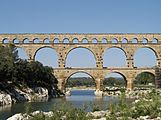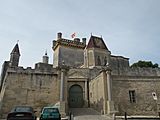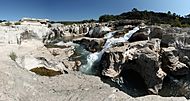Gard facts for kids
Quick facts for kids
Gard
|
|||
|---|---|---|---|

Prefecture building of the Gard department, in Nîmes
|
|||
|
|||

Location of Gard in France
|
|||
| Country | France | ||
| Region | Occitanie | ||
| Département | 4 March 1790 | ||
| Prefecture | Nîmes | ||
| Subprefectures | Alès, Le Vigan | ||
| Area | |||
| • Total | 5,852.8 km2 (2,259.8 sq mi) | ||
| Population
(2014)
|
|||
| • Total | 736,029 | ||
| • Rank | 33 | ||
| • Density | 125.7567/km2 (325.7084/sq mi) | ||
| Demonym(s) | Gardois | ||
| Time zone | UTC+1 (CET) | ||
| • Summer (DST) | UTC+2 (CEST) | ||
| ISO 3166 code | FR-30 | ||
| Arrondissements | 3 | ||
| Cantons | 23 | ||
| Communes | 353 | ||
| Website | http://www.gard.fr/ | ||
Gard is a French department in southern France in the Occitanie region and named after the Gardon river. Its prefecture is Nîmes.
Contents
History
Gard is one of the 83 French departments made during the French revolution, on 4 March 1790. It was divided in 8 districts: Alais, Beaucaire, Nîmes, Pont-Saint-Esprit, Saint-Hippolyte, Sommières, Uzès and Le Vigan. The capital was Nîmes alternating with Alais and Uzès. In 1794, Nîmes became the only capital.
With the creation of the arrondissements, the 8 districts became four arrondissements: Nîmes, Alais, Uzès and Le Vigan. In 1926, the arrondissement of Uzès was eliminated.
Geography
Gard is part of the Occitanie region, in southern France, with an area of 5,852.8 km2 (2,260 sq mi).
The department borders with 6 other departments in 3 regions:
- Provence-Alpes-Côte d'Azur
- Bouches-du-Rhône (south)
- Vaucluse (east)
- Auvergne-Rhône-Alpes
- Ardèche (north)
- Occitanie
The department has a 23 km (14 mi) long coast along the Mediterranean Sea.
 |
Lozère | Ardèche |  |
|
| Aveyron | Vaucluse | |||
| Hérault | Mediterranean Sea | Bouches-du-Rhône |
There are 4 natural regions in Gard:
- The Cévennes, a mountain chain that is part of the Massif Central. It is between the Lozère and Gard departments.
- The Garrigues, a natural region found in the Hérault and Gard departments. It is formed by hills and plateaus of limestone.
- The Costières, a natural region of the Gard department found to the south of Nîmes.
- The low region formed by the plains of the Rhone river and those along the coast.
The highest point in the department is Mont Aigoual, (44°7′17″N 03°34′53″E / 44.12139°N 3.58139°E) that is 1,565 m (5,135 ft) high it is in the Cévennes mountains, on the border with the Lozère department.
The main river of Gard is the Gardon (or Gard), a right tributary of the Rhone. The Rhone flows through the eastern border of the department.
Climate
The climate of the Gard department, in the city of Nîmes, is subtropical with dry-summer, Csa (Mediterranean Climate) in the Köppen climate classification.
The average temperature for the year in Nîmes, at an altitude of 60 m (200 ft), is 14.4 °C (57.9 °F). The warmest month, on average, is July with an average temperature of 23.3 °C (73.9 °F). The coolest month on average is January, with an average temperature of 6.1 °C (43.0 °F).
The average amount of precipitation for the year in Nîmes is 690.9 mm (27.2 in). The month with the most precipitation on average is October with 106.7 mm (4.2 in) of precipitation. The month with the least precipitation on average is July with an average of 25.4 mm (1.0 in).
Administration
Gard is part of the region of Occitanie. The department is managed by the Departamental Council of the Gard in Nîmes.
Administrative divisions
There are 3 arrondissements (districts), 23 cantons and 353 communes (municipalities) in Gard.
| INSEE code |
Arrondissement | Capital | Population (2014) |
Area (km²) |
Density (Inh./km²) |
Communes |
|---|---|---|---|---|---|---|
| 301 | Alès | Alès | 151,823 | 1,321.6 | 114.9 | 101 |
| 302 | Nîmes | Nîmes | 547,598 | 3,132.8 | 174.8 | 177 |
| 303 | Le Vigan | Le Vigan | 36,608 | 1,398.5 | 26.2 | 75 |
The following is a list of the 23 cantons of the Gard department (with their INSEE codes), in France, following the French canton reorganisation which came into effect in March 2015:
- Aigues-Mortes (3001)
- Alès-1 (3002)
- Alès-2 (3003)
- Alès-3 (3004)
- Bagnols-sur-Cèze (3005)
- Beaucaire (3006)
- Calvisson (3007)
- La Grand-Combe (3008)
- Marguerittes (3009)
- Nîmes-1 (3010)
- Nîmes-2 (3011)
- Nîmes-3 (3012)
- Nîmes-4 (3013)
- Pont-Saint-Esprit (3014)
- Quissac (3015)
- Redessan (3016)
- Roquemaure (3017)
- Rousson (3018)
- Saint-Gilles (3019)
- Uzès (3020)
- Vauvert (3021)
- Le Vigan (3022)
- Villeneuve-lès-Avignon (3023)
Demographics
The inhabitants of Gard are known, in French, as Gardois (women: Gardoises).
Gard has a population, in 2014, of 736,029, for a population density of 125.8 inhabitants/km2. The arrondissement of Nîmes, with 547,598 inhabitants, is by far the largest. The other two, Alès and Le Vigan, have respectively 151,823 and 36,608 inhabitants.
The city with more people living in it is the capital, Nîmes (151,075). The subprefectures of Alès and Le Vigan have, respectively, 39,993 and 3,933 inhabitants.
Evolution of the population in Aude

The 10 most important cities in the department are:
| City | Population (2014) |
Arrondissement |
|---|---|---|
| Nîmes | 151,075 | Nîmes |
| Alès | 39,993 | Alès |
| Bagnols-sur-Cèze | 18,172 | Nîmes |
| Beaucaire | 15,859 | Nîmes |
| Saint-Gilles | 13,326 | Nîmes |
| Villeneuve-lès-Avignon | 11,716 | Nîmes |
| Vauvert | 11,353 | Nîmes |
| Pont-Saint-Esprit | 10,155 | Nîmes |
| Marguerittes | 8,577 | Nîmes |
| Uzès | 8,569 | Nîmes |
Gallery
-
Arena of Nîmes
-
Pont du Gard bridge
-
Sautadets Waterfalls on the Cèze river
Related pages
Images for kids
See also
 In Spanish: Gard para niños
In Spanish: Gard para niños








